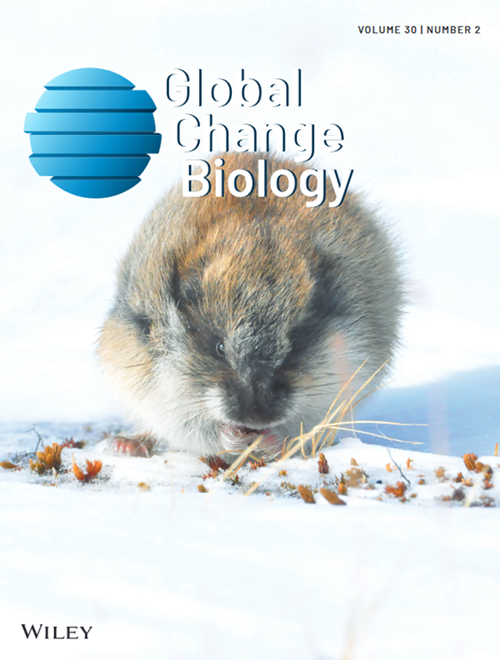Land Use Impacts on Local and Regional Freshwater Biodiversity Can Compromise Current Management Goals
IF 12
1区 环境科学与生态学
Q1 BIODIVERSITY CONSERVATION
引用次数: 0
Abstract
Land use and other anthropogenic activities are degrading freshwater ecosystems and their biodiversity worldwide. Although results from long‐term monitoring networks suggest that freshwater biodiversity may not be undergoing significant change, information about how freshwater biodiversity has changed and the effectiveness of current environmental goals remains limited. We used nationwide survey data of stream diatoms, macroinvertebrates, and lake diatoms, macroinvertebrates, and macrophytes to examine how land use has changed freshwater biodiversity in Finland and how effective good ecological status class, that is, the main environmental goal for freshwater ecosystems in the European Union, is for protecting biodiversity. We employed RIVPACS‐type multitaxon distribution models with independent validation sites to assess observed to expected ratios of local taxa (O/E) as well as differences in observed and expected regional frequencies of taxa. Land use negatively impacted local diversity of both examined stream communities (mean difference in O/E to near natural reference streams > 0.076), while lake communities were affected by only agriculture and multiple pressures (mean difference in O/E to near natural reference lakes > 0.093). Regional taxon prevalences were significantly reduced in all land use groups for diatoms (21%–61% of taxa), lake macrophytes (21%–39%), and macroinvertebrates (11%–65%), but also increased particularly for diatom (24%–26%) and macrophyte (29%) species in agricultural areas. Species with decreased frequency were generally sensitive species, while species that increased in their frequency were tolerant species typical for mesotrophic or eutrophic conditions. In the good ecological status class, frequencies were also changed, and for some groups such as stream macroinvertebrates, there were substantial changes (66% of taxa declined), indicating that the current management goal may be partially insufficient to protect freshwater biodiversity. Our study highlights that there is a need to incorporate freshwater biodiversity in the environmental objectives to ensure effective conservation and restoration efforts.土地利用对当地和区域淡水生物多样性的影响可能会损害当前的管理目标
土地利用和其他人为活动正在使全世界的淡水生态系统及其生物多样性退化。尽管长期监测网络的结果表明淡水生物多样性可能没有发生重大变化,但关于淡水生物多样性如何变化以及当前环境目标有效性的信息仍然有限。我们使用了全国范围内的河流硅藻、大型无脊椎动物、湖泊硅藻、大型无脊椎动物和大型植物的调查数据来研究土地利用如何改变芬兰的淡水生物多样性,以及良好的生态状态等级(即欧盟淡水生态系统的主要环境目标)如何有效地保护生物多样性。我们采用具有独立验证点的RIVPACS型多分类群分布模型来评估本地分类群的观测与预期比率(O/E),以及分类群的观测频率与预期区域频率的差异。土地利用对河流群落的局部多样性均有负面影响(O/E与自然参考湖泊的平均差异为0.076),而湖泊群落仅受到农业和多重压力的影响(O/E与自然参考湖泊的平均差异为0.093)。在所有土地利用类型中,硅藻(21% ~ 61%)、湖泊大型植物(21% ~ 39%)和大型无脊椎动物(11% ~ 65%)的区域分类群患病率显著降低,但在农业区,硅藻(24% ~ 26%)和大型植物(29%)物种的区域分类群患病率显著升高。频率降低的物种通常是敏感物种,而频率增加的物种是典型的中营养或富营养条件下的耐受性物种。在生态状况良好的类群中,出现频率也发生了变化,其中溪流大型无脊椎动物等类群发生了较大的变化(66%的类群减少),表明目前的管理目标可能在一定程度上不足以保护淡水生物多样性。我们的研究强调,有必要将淡水生物多样性纳入环境目标,以确保有效的保护和恢复工作。
本文章由计算机程序翻译,如有差异,请以英文原文为准。
求助全文
约1分钟内获得全文
求助全文
来源期刊

Global Change Biology
环境科学-环境科学
CiteScore
21.50
自引率
5.20%
发文量
497
审稿时长
3.3 months
期刊介绍:
Global Change Biology is an environmental change journal committed to shaping the future and addressing the world's most pressing challenges, including sustainability, climate change, environmental protection, food and water safety, and global health.
Dedicated to fostering a profound understanding of the impacts of global change on biological systems and offering innovative solutions, the journal publishes a diverse range of content, including primary research articles, technical advances, research reviews, reports, opinions, perspectives, commentaries, and letters. Starting with the 2024 volume, Global Change Biology will transition to an online-only format, enhancing accessibility and contributing to the evolution of scholarly communication.
 求助内容:
求助内容: 应助结果提醒方式:
应助结果提醒方式:


